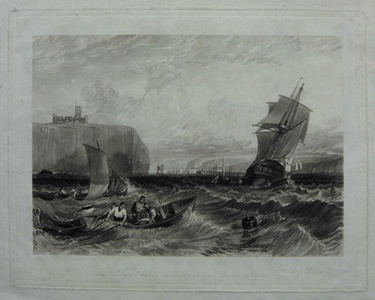| Method | Mezzotint |
| Artist | Thomas Lupton after J.M.W. Turner |
| Published | London Published April, 1st 1826 by Thomas Lupton |
| Dimensions | Image 150 x 220 mm, Plate 197 x 255 mm, Sheet 288 x 403 mm. |
| Notes |
Inscription reads: 'Whitby, Plate 2'. Rawlinson 780, engravers proof. Acting in the capacity of both publisher and engraver, The Ports of England (1826-8) was conceived by Thomas Lupton and intended to stand as a companion piece to William Bernanrd Cooke's The Rivers of England. J.M.W Turner was the commissioned artist, though of the twenty-four port subjects specified in the brief, only twelve were completed. John Ruskin, the great Victorian critic, closely collaborated with Lupton on the project and provided a profile of each harbour featured within the volume. The faltering series was revived and reissued in 1856 by Ernest Gambart under the title The Harbours of England. Subsequent reprints followed in 1859 and 1872 but these were of an inferior quality. In 1877, Smith, Elder & Co. published what Rawlinson described as 'carefully reworked' and 'superior' versions of the original plates. Thomas Lupton (1791-1873) was an English mezzotinter who produced many works by Turner as well as a host of other notable British painters of the nineteenth-century. A talented engraver, Lupton also played a significant role in the technical advancement of the mezzotint. In the hope of finding a more durable replacement for copper plate, Lupton conducted lengthy experiments on Chinese tutenag, nickel, and steel. The latter proved the most perspicacious. So much so that after 1,500 impressions, a single soft steel plate could still produce remarkable prints. Lupton's endeavour was recognised by the Royal Society of Arts and he was awarded the Isis medal in 1822. Condition: Light dirt build up to sheet, foxing to margins, tears and creases to edges of sheet, not affecting image. Light creases to printed area. |
| Framing | unmounted |
| Price | £180.00 |
| Stock ID | 31491 |

